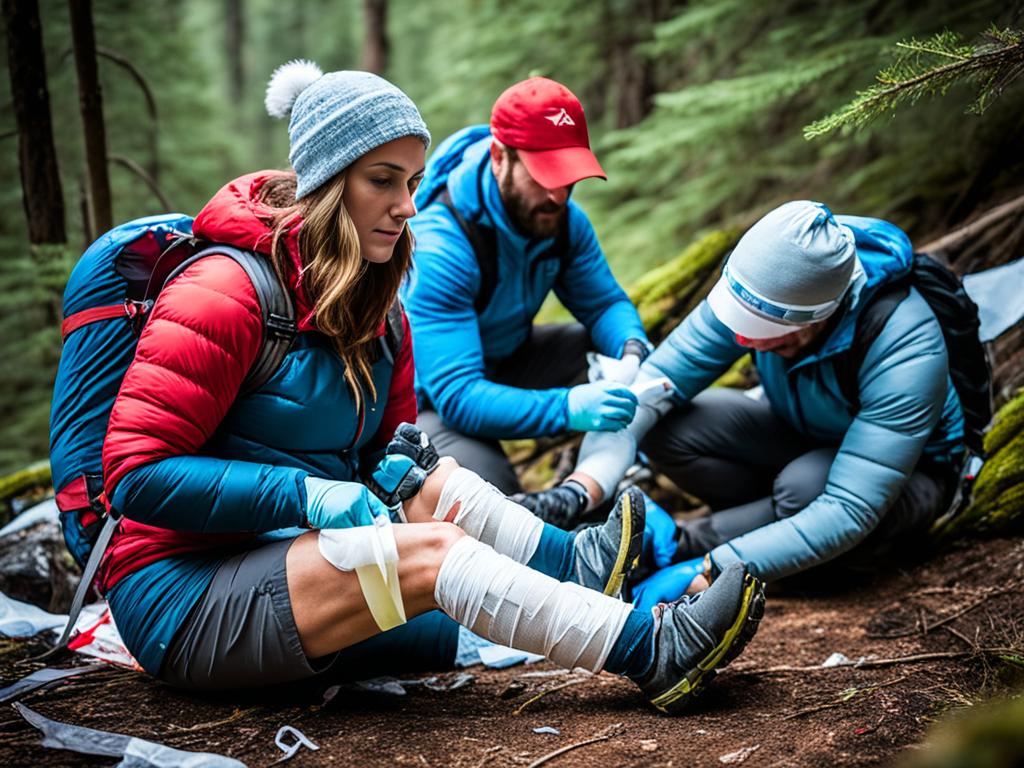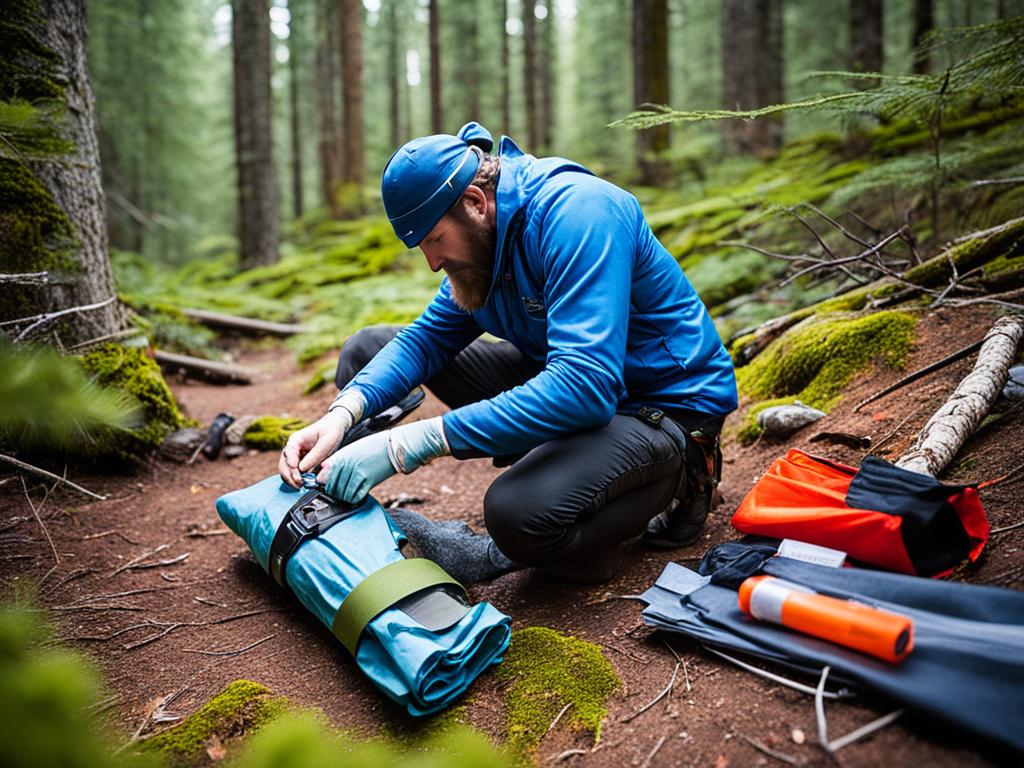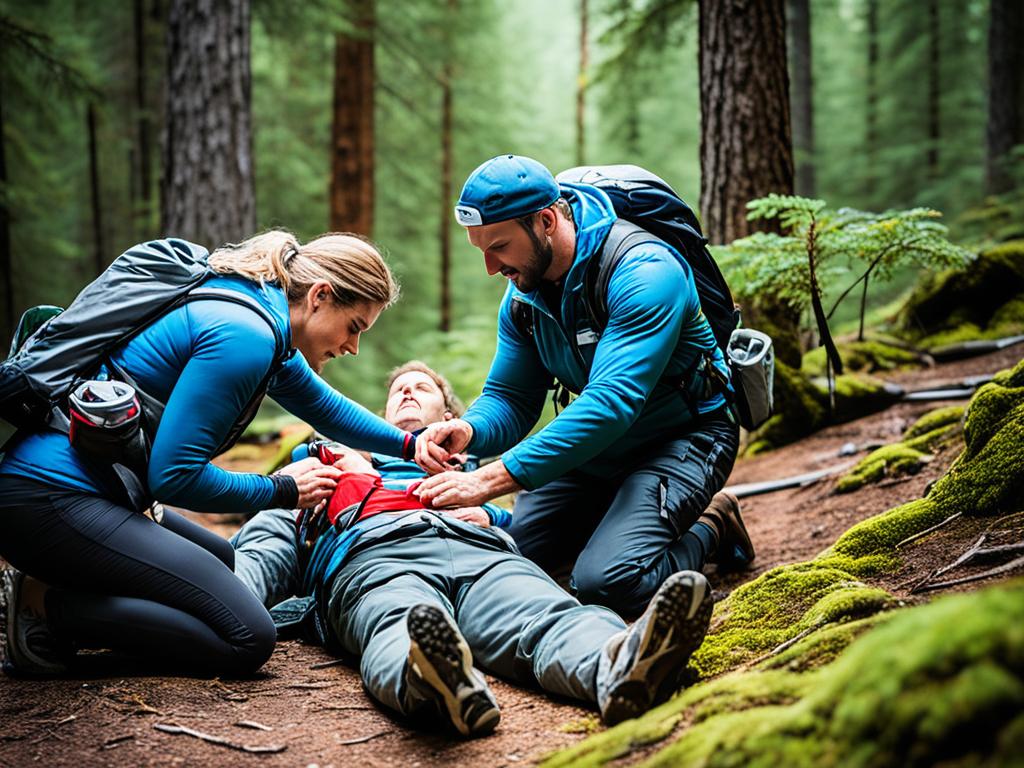When nature’s peace turns into the unexpected, having knowledge is your best friend. I’ve explored the outside world, loving its wonders and facing its risks. I learned how critical wilderness first aid is in emergencies. It helps everyone, whether you explore often or just enjoy an occasional hike. These skills can turn trouble into relief and even save lives in serious situations.
What if your adventure suddenly became a quest for survival? Learning how to respond to emergencies in the wild isn’t just about being ready. It’s about creating a sense of safety, hope, and stamina when times are tough. By sharing true stories and key tips, we’ll look into the life-saving skills of wilderness first aid. In these moments, every second and every action is crucial.
Key Takeaways:
- Learning vital wilderness first aid skills can be lifesaving.
- Knowing how to do survival first aid helps you act confidently in nature’s crises.
- Getting full training on how to respond to wilderness emergencies makes you ready for anything.
- Stories from real life show how important first aid knowledge is in extreme cases.
- Everyone, beginners and pro adventurers alike, should learn these essential survival techniques.
The Importance of Being Prepared for Wilderness Emergencies
Heading outdoors means stepping into the unknown. That’s what makes it an adventure. But it also means you need strong outdoor first aid skills. My hiking and camping trips have shown me that being ready is essential, not optional.
Understanding Potential Risks in the Wild
Knowing what risks the wilderness holds is key to staying safe. Weather extremes or tough terrain demand special backcountry first aid procedures. If you know what dangers might come, you can act fast and smart in an emergency.
Benefits of Wilderness First Aid Knowledge
Learning first aid does more than protect you; it protects everyone. Being able to help in an outdoor medical emergency means peace of mind. It can change a potential disaster into something you can handle.
Packing an Effective First Aid Kit
What’s in your first aid kit can really make a difference. It should be packed for small issues and big emergencies. Here’s a list of must-haves. They are for general use and for specific backcountry first aid procedures. This ensures you’re ready for anything.
| Item | Purpose | Notes |
|---|---|---|
| Bandages | Covering cuts and abrasions | Include various sizes |
| Antiseptics | Cleanse wounds | Consider wipes for ease of use |
| Splints | Immobilization of fractures | Lightweight, adaptable materials |
| Compression Wraps | Manage sprains and swelling | Reusable, elasticated bandages preferred |
| Allergy Medication | Treating allergic reactions | Include antihistamines and EpiPens if necessary |
| Thermal Blanket | Prevention of hypothermia | Compact and reflects body heat |
Assessing Emergency Situations in The Wilderness
Going into the wild? Being ready is crucial for dealing with surprises. I’ll guide you through crucial emergency medical care in the wild. You’ll learn to quickly check and tackle urgent health issues far from city hospitals.
Primary Survey: Assessing the Scene and Victim
Start with the primary survey. Here, quick thinking and observing are key. They can keep a situation from getting worse. Make sure you and the victim are safe from dangers before delivering wilderness medicine essentials. This fast check covers responsiveness, breathing, and serious bleeding.
Secondary Survey: A Detailed Analysis
Once the area is safe, do the secondary survey. This part is for a full look-over. You’ll search for injuries or sicknesses that need care even if they seem minor now. Your head-to-toe check will find any needed medical help.
Establishing a Plan of Action
After checking everything, make a plan. Effective emergency care outdoors relies on a good, step-by-step plan. This can be setting a bone, treating a cut, or getting ready to move. Your strategy allows you to give emergency medical care in the wild. Watch the patient’s health signs closely and be ready for changes.
| Primary Survey | Secondary Survey | Plan of Action |
|---|---|---|
| Assess immediate threats | Head-to-toe examination | Continuously monitor vitals |
| Establish responsiveness | Identify non-obvious injuries | Determine the need for evacuation |
| Check for severe bleeding | Take note of patient history | Apply outdoor injury treatment strategies |
| Ensure a safe environment | Gather gear for treatment | Reassess and adjust plan as needed |
Knowing wilderness medicine essentials helps us not just survive, but also assist others. How we assess, analyze, and act matters a lot during wild medical emergencies.
Managing Wounds and Bleeding in Outdoor Settings
Out in the wilderness, injuries like wounds and bleeding are common. I’ve learned that outdoor injury treatment strategies are vital. Knowing wilderness first aid techniques for emergencies is a must for everyone.
Applying direct pressure to a wound is your first step. Use a clean bandage or cloth to press down firmly. This helps stop the blood flow.
If the bleeding doesn’t stop with direct pressure, consider a tourniquet. This is advanced and should only be done when truly needed. It’s a part of outdoor injury treatment strategies that can save lives.
It is paramount to take wilderness injuries seriously. Treat every bleeding incident with decisive action and proper aftercare to prevent infection and complications.
Below is a practical guide on wound management. It shows steps for dealing with injuries you might face:
| Type of Wound | First Aid Response | Additional Considerations |
|---|---|---|
| Minor Scratches and Cuts | Clean with water, apply antiseptic, cover with bandage | Monitor for signs of infection |
| Major Wounds | Apply pressure, elevate if possible, bandage tightly | Prepare for evacuation if necessary |
| Severe Bleeding | Use tourniquet or pressure dressing | Never loosen tourniquet once applied |
Incorporating wilderness first aid techniques for emergencies into your skills is essential. Hands-on training is invaluable for learning life-saving methods.
Whether you’re out for a weekend or deep in the backcountry, knowing wilderness first aid techniques for emergencies is crucial. Being prepared can save lives.
Wilderness First Aid Techniques for Emergencies: Addressing Sprains and Fractures
Heading into the wild requires not just courage, but also outdoor first aid skills. These skills are necessary not only for your safety but also to help others around you. In the wild, it’s common to suffer from sprains and fractures due to accidents. When far from a hospital, knowing how to handle these injuries becomes vital. Let’s dive into some key techniques to identify and treat sprains and fractures outdoors.
Remember: Proper first aid can prevent further injury and can make the difference between a swift recovery and prolonged disability.
First, you need to recognize if it’s a sprain or fracture. Signs include pain, swelling, and difficulty moving the affected area. In cases of fractures, the shape of the limb might look wrong. After spotting the injury, proceed with the R.I.C.E method:
- Rest: Get the injured person to rest, stopping use of the hurt limb.
- Ice: Apply cold to lessen swelling and pain. No ice? Use cold stream water.
- Compression: Wrap the area gently with a bandage to keep swelling down.
- Elevation: Raise the injury above the heart, if you can, to help with swelling.
If the injury is serious, like a fracture, keeping it still is crucial. You might need to get creative with what’s around. Here’s a guide for making supports:
| Injury | Immobilization Technique | Materials | Notes |
|---|---|---|---|
| Arm Fracture | Splint | Sticks, magazines, clothing | Make sure the splint covers the joints above and below the fracture. |
| Ankle Sprain | Wrap and Elevate | Elastic bandage, pillow | Wrap firmly but ensure it’s not too tight, to avoid blocking circulation. |
| Wrist Fracture | Sling | Triangular bandage, shirt | Keep the arm raised to help reduce swelling. |
| Leg Fracture | Traction Splint | Poles, belts, clothing | Keep the limb straight; get help if possible. |
Learning these outdoor first aid skills could save a life when medical help is far away. Being able to use what you find around you is a big part of survival first aid methods. Thus, knowing these techniques is crucial for anyone venturing into the wilderness.

Finally, remember that professional medical help is vital after giving first aid. These steps are meant to offer temporary help and stabilization. Make sure the injured person sees a healthcare professional afterward.
Recognizing and Treating Hypothermia and Heat-Related Illnesses
When you’re out in the wild, knowing wilderness first aid techniques for emergencies can be life-saving. Hypothermia and heat-related illnesses can catch you off guard. It’s vital to know the signs and how to treat them quickly.
Identifying Symptoms of Temperature-Related Injuries
First, know the symptoms of these emergencies. Hypothermia happens when your body loses heat too fast, making your body temperature drop. Look for signs like:
- Uncontrollable shivering
- Slurred speech
- Slow, shallow breathing
- Drowsiness and exhaustion
Heat-related illnesses, like heat exhaustion or stroke, happen from being too hot. Watch for signs like:
- Heavy sweating with cold, pale skin
- Nausea or vomiting
- Weak pulse
- Fainting or dizziness
Catching these wilderness medicine essentials early can mean a quick recovery instead of serious risk.
Immediate Actions to Take for Hypothermia
If you think someone has hypothermia, you must act fast. Start by:
- Moving them to a warm place right away.
- Changing wet clothes for warm, dry ones.
- Give them warm drinks to help their body temperature.
Focus on warming the body’s center first like the chest and head. Be careful to not burn the skin or cause heartbeat problems.
Preventing and Handling Heat Exhaustion and Stroke
To stop heat-related illnesses, you should:
- Stay hydrated by drinking lots of water.
- Dress in lightweight and loose clothes.
- Take breaks in the shade often.
If you see someone with heat exhaustion, help them by:
- Moving them somewhere cool.
- Giving them water or sports drinks to sip.
- Applying cool cloths or suggesting a cool bath.
Heatstroke is a big deal and needs quick care to cool down while you wait for medical help.
| Condition | Symptoms | Immediate Actions |
|---|---|---|
| Hypothermia | Shivering, slurred speech, slow breathing | Warm shelter, dry clothing, warm beverages |
| Heat Exhaustion | Heavy sweating, nausea, weak pulse | Cool environment, hydration, cool cloths |
| Heatstroke | High body temperature, altered mental state | Cool body urgently, call emergency services |
Knowing wilderness first aid techniques for emergencies and wilderness medicine essentials is crucial for any adventure. Keep these tips in mind to stay safe in the wild.
Navigating Challenges of Outdoor Injury Treatment
Being passionate about the outdoors, I focus on outdoor medical emergency assistance. Nature’s unpredictability demands flexibility in first aid. Treating injuries in remote areas requires special wilderness emergency response training. You need to adapt to the surroundings, use limited resources wisely, and know when to call for evacuation.

Adapting First Aid Techniques to the Environment
Every situation in the wild is different. It asks for creativity. A big part of backcountry first aid procedures is adjusting standard methods to fit the environment. This could mean making splints from branches or using snow as a cold compress. The goal is to modify techniques without lowering care quality.
Dealing with Limited Resources
In the wilderness, resources are often limited. I’ve learned to work with what I have. Using wilderness emergency response training, I’ve become skilled at using my surroundings for treatment. Knowing how to use each item in your first aid kit in several ways is crucial. It helps you manage different injuries or sicknesses.
When and How to Evacuate
Sometimes, an injury in the wilderness needs more help than what can be given on site. Knowing when to evacuate is key to outdoor medical emergency assistance. You must weigh the injury’s severity against the risks of moving someone. You also need to know how to contact a rescue team. This decision-making is a vital part of wilderness emergency response training.
Handling Animal and Insect Bites in the Wild
Heading into the wild means you must know wilderness first aid techniques for emergencies. In my own adventures, being ready with outdoor injury treatment strategies mattered a lot. I’ll share tips on dealing with bites from animals and bugs.
First, figure out what bit you. It’s key to treating the bite correctly. Whether it’s a bite from a snake, spider, tick, or another creature, knowing the details can help you act fast. Let’s talk about what to do right after a bite. The first step is to lower infection risk and handle any allergies. This is when your wilderness first aid techniques for emergencies come into play.
- Keep the bite still and raised to slow down any venom or irritants.
- Wash the bite with soap and water to avoid infection.
- Watch for allergic reactions like hard breathing or swelling, and get urgent care if you see these signs.
Feeling scared in these scenarios is normal, but staying calm is part of outdoor injury treatment strategies. Allergic reactions need quick action, so rush to get help if things get worse.
Sometimes, you might have to take out a stinger or tick. Pull it out carefully with thin tweezers to get it all out. After a tick bite, look for signs like fever, chills, or rashes. These could mean Lyme disease.
In summary, always be mindful of the wildlife around you. With the right wilderness first aid techniques for emergencies, you can manage bites well. Tip: if you’re really allergic, carry an epinephrine auto-injector and keep learning about wilderness medicine. It’s your best defense against wild dangers.
Wilderness Medicine Essentials: Shock and Ailment Management
In an emergency in the wilderness, knowing how to manage shock and common illnesses is critical. Using survival first aid methods and staying calm are key. I’ll share important steps for dealing with these issues, drawing from my wilderness emergency training.
Understanding Shock in a Wilderness Context
Shock occurs when the blood flow to vital organs is too low. It can happen from injuries, lack of water, or allergic reactions in the wild. To fight shock, lay the person flat, lift their legs, keep them warm, and offer support until you can get help or reach a hospital using wilderness first aid techniques for emergencies.
Key Strategies for Managing Common Wilderness Ailments
- Dehydration: Avoid it by making sure everyone drinks enough, and treat it with fluids and salts.
- Diarrhea: Prevent it with clean practices and treat it with special hydration solutions.
- Altitude Sickness: Go up slowly to avoid it, and go down right away if feeling ill.
These tips can help handle many issues you might face outdoors. They’re a big part of wilderness emergency response training.
Prioritizing Care in Multi-Injury Scenarios
When dealing with several injuries, knowing what to do first is crucial. I use triage to address the most serious problems. This includes stopping heavy bleeding, making sure the airway is clear, and managing shock risks. Your skills in wilderness first aid techniques for emergencies are very valuable in such moments.
Using these survival first aid methods boosts your confidence in handling emergencies in isolated places. It could even save someone’s life. Always remember, being well-prepared and informed is powerful.
Conclusion
We’ve learned a lot about first aid in the wild. These skills are both varied and critical. It’s important for us to know these, not just for our safety, but to help others too. What we’ve learned goes beyond simple tips. It’s a complete guide to keeping alive in the beauty of nature.
Providing emergency care outdoors is like dancing with nature. You need to be alert, stay calm, and quickly adjust. I’ve shared knowledge from experts and my own experiences. This is because using what we know in real situations is what truly matters. I hope this info makes you feel ready and confident to face the unknown.
Now, as you head back out, you’re better prepared for emergencies. Remember, learning and practicing these skills is an ongoing process. Adventures in the wild can seem scary, but knowing first aid changes that. You become more than just an adventure seeker; you’re a protector of life. So, wherever you go, be watchful and caring—for the environment, for others, and for yourself.

